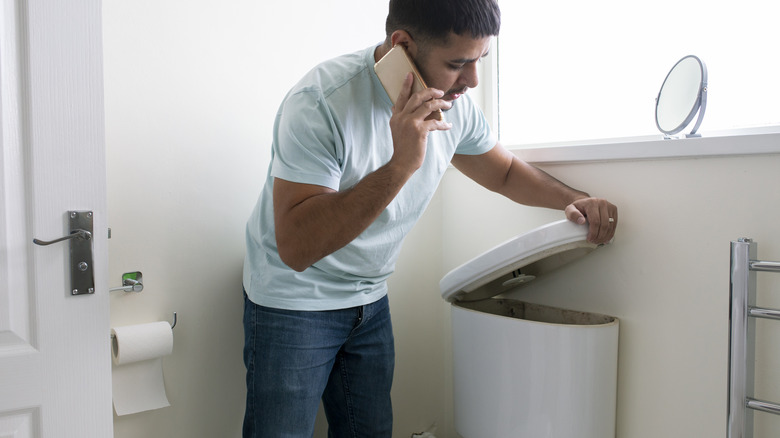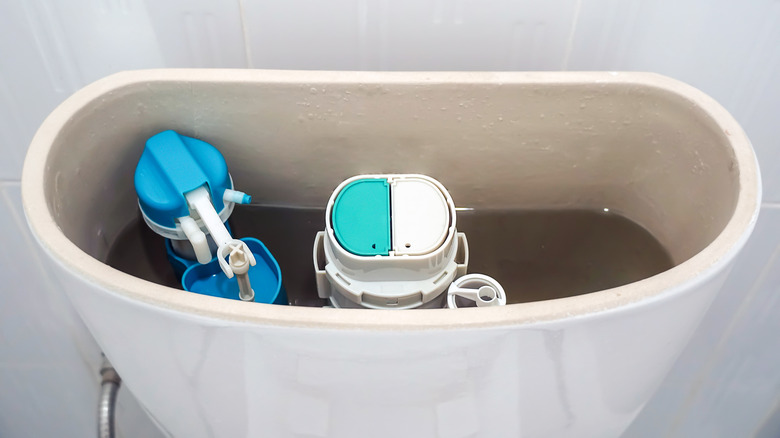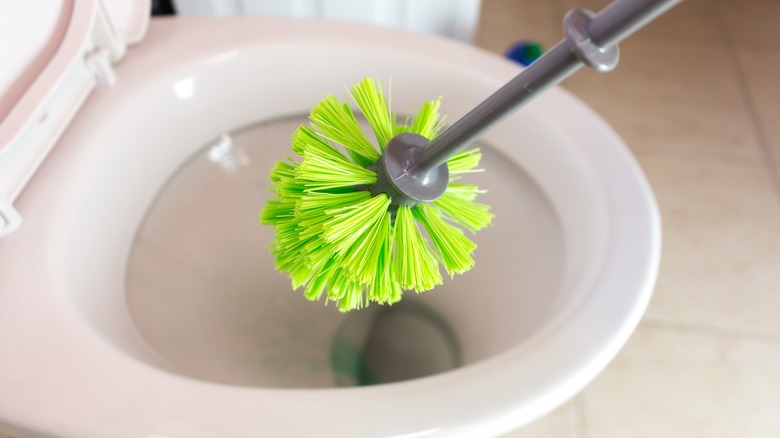Hard Water Might Be The Cause Of Your Toilet's Problems
Unless you have a fully working water softener, your toilet and other appliances are susceptible to damage from the buildup of minerals in your home's hard water. Dissolved minerals such as calcium and magnesium that are left behind when hard water in the toilet bowl evaporates build up over time, which can lead to the formation of limescale. Limescale is notoriously difficult to get rid of once it makes an appearance, and while hard water buildup can be unsightly, limescale buildup in your toilet's pipes can lead to a complete breakdown of your toilet's plumbing and functionality.
While your washing machine and dishwasher are equally susceptible to the unsightly and potentially damaging effects of hard water buildup, people most commonly notice it in the toilet bowl. It usually manifests in the form of a rust-colored ring in line with the water level in the bowl. While these marks and lines in the toilet bowl are reason enough to want to prevent hard water buildup, if the deposits are allowed to accumulate enough, they can plug drainage lines and hinder your toilet's ability to properly flush and refill — ultimately shortening its lifespan.
How does hard water damage your toilet?
All parts of your toilet can easily become damaged from hard water over time if the right precautions are not taken. Mineral deposits from hard water buildup can form on the surface of the bowl from the standing hard water, while the functionality of the pipes and flushing mechanism can be depleted over time from buildup that worsens with every flush. These mineral buildups in the pipes can narrow them over time, which can reduce the amount of water that is able to flow with every flush and fill. While this can begin as slow flushing, eventually it can lead to consistent clogging or even leaking of the pipes. Not only do frequent leaks and clogs in the pipes prevent you from fully accessing the basic necessities of your home's toilet, but they can also lead to more serious issues with highly pressurized, backlogged water dripping inside the walls, leading to mold.
When a toilet is flushed, water runs from small holes in the underside of the rim into the toilet bowl to fill it back up. If your home has hard water, those holes can also become blocked and narrowed from limescale buildup over time, which can prevent water from properly refilling the bowl after every flush. Limescale buildup from hard water can also accumulate inside of your toilet's tank, which can cause the internal components to corrode over time.
How to remove hard water buildup from your toilet
The easiest way to remove hard water buildup from your toilet is to use an acidic cleaner such as white vinegar. Because the anti-scaling properties of vinegar are more powerful when the vinegar is not diluted with water, you'll want to remove all of the water from your toilet bowl and tank prior to applying any vinegar. To accomplish this, turn off the toilet's water valve, which is usually located somewhere near the floor behind your toilet. Now, flush the toilet a few times to completely drain the bowl and tank of water. With the water valve turned off, they won't refill after each flush.
Next, pour your porcelain-safe cleaner onto the mineral buildup and let it sit for a while. If you are using a cleaning solution containing vinegar, be careful not to let the solution sit on the porcelain for too long, as the acidity in the vinegar can eat away at the toilet. With a stiff bristled handheld cleaning brush, work the cleaning solution into all areas and angles of the bowl and let it sit for about a half hour. Work the bristles into the holes under the seat as much as you can. Repeat this step as many times as it takes for the limescale and hard water stains to disappear from the bowl completely. (If you turned off your toilet's water valve during this step, don't forget to turn it back on when you're done so the toilet refills the next time you flush!)
How to prevent hard water buildup in toilet
Mineral deposit stains from hard water buildup are notoriously tricky to remove completely, which is why preventing them is so important — and the much easier option, if you can help it. It goes without saying that the simplest and most guaranteed way to minimize and prevent hard water buildup and stains from limescale and calcium deposits is to invest in a house water softener if you don't already have one. With that being said, this is not always the cheapest solution, and a water softener may not be within the budget. If you're curious about installing a water softener, many installation companies offer payment or leasing plans, so if you can afford a water softener on a payment schedule, the result will undoubtedly be worth it.
If you don't have a working water softener and aren't able to have one installed, don't fret! With regular maintenance and cleaning of your toilet and other appliances that use water, you can prevent the worst of the damage from any potential mineral buildup from your house's hard water. Scrub your toilet bowl weekly with an acidic cleaner, the easiest and most commonly on-hand option being white vinegar. This will work to combat any existing buildup in the works before it's allowed to get too bad. Additionally, pouring white vinegar directly into your toilet's tank on a monthly basis can help prevent any potential hard water buildup. Just add 1 cup and allow it to sit in the tank for 30 minutes before flushing.


